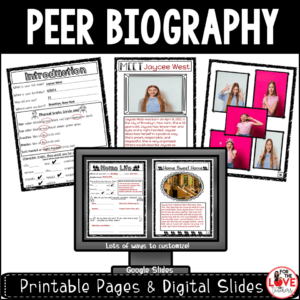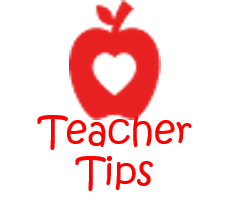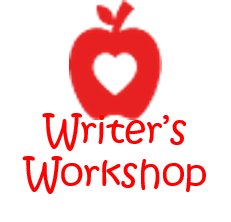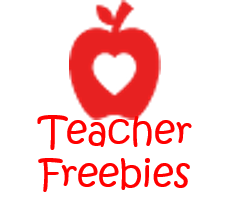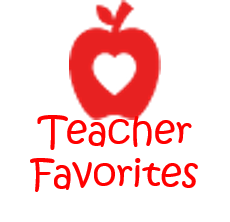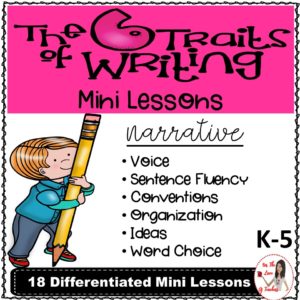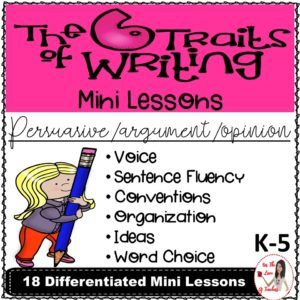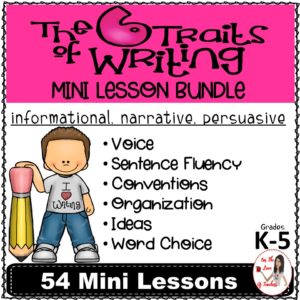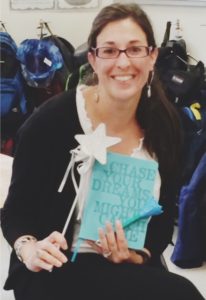
Students name their teacher, The Writing Fairy
Teaching writing is my absolute passion. It’s my favorite subject to teach and my students love it too. My enthusiasm and love for writing really rubs off on them. Even my most reluctant writers will say at some point in the year that they love writing. That’s why my students named me the “writing fairy.”
Writing Like Writers is the name of the Writer’s Workshop in my classroom that encourages all students to think of themselves as writers. We begin the year off by creating the routines and expectations for our workshop that establishes an environment where writers feel safe and comfortable writing about topics they want to write about. The key to getting students to write is giving them choices about what to write about. Help them to discover their passions to share with others. All children have something they are passionate about. They all have stories to tell that are meaningful to them. When you help them find those stories within themselves you will find that your students just can’t stop writing.
Elements of the Writer’s Workshop Process
-
Students choose their own topics. They write about what they want to write about and what they know a lot about.
-
Students keep a writer’s journal to draft their writing.
-
Students work at their own pace. Some may be prewriting while others are at the editing stage.
-
The teacher’s role is that of the facilitator: monitoring, encouraging, conferring, and providing help as needed, teaching the writer, not the writing.
-
Students peer confer with each other for the purpose of giving meaningful feedback to help improve the writing.
-
Students have time to orally share their writing.
-
The teacher uses a “status of the class” chart to keep track of where students are in the writing process and when a conference is needed.
-
The teacher meets with individual students to confer about their writing throughout the process.
-
The teacher may meet with a small group to teach a skill, strategy, or technique.
Organizing the Classroom:
-
Set the tone for the classroom environment for writing
-
Model and establish exact routines and procedures
-
Establish locations in the classroom for materials and the components of Writer’s Workshop
The Writing Center
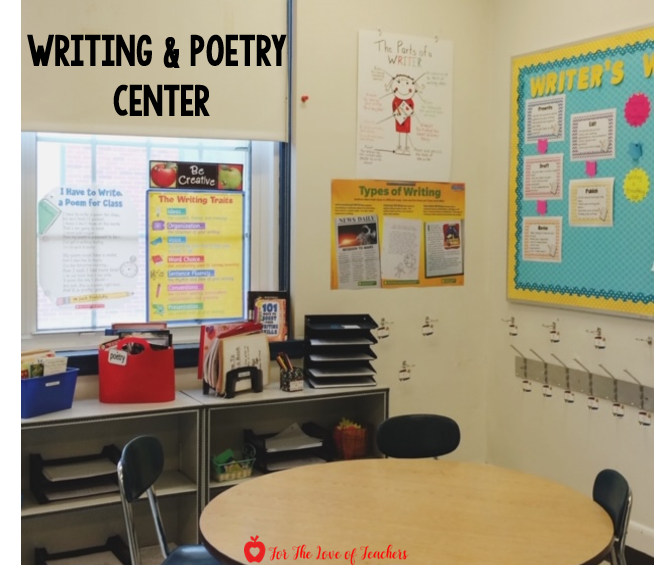
The writing center is stocked with all materials and supplies needed for Writer’s Workshop: pencils, crayons, markers, paper (lined, letter templates, drawing paper, construction paper, etc.), writing prompts, anchor charts, writing activities, books about writing and mentor texts, Make a Book Station and more!
A Snapshot:
-
Mini-Lesson (10-15 minutes) A short lesson focused on a single topic that teaches a single writing concept. You do not need to give a mini-lesson each day; 2-3 times a week is fine. (Location: large meeting area for whole group lesson)
-
Status of the Class (2-5 minutes) A quick way of finding out what each student is working on and where they are in the writing process.
-
Writing time (20-30 minutes) Students write. The teacher writes with students and/or confers with individual students or small groups. (Location: At student desks)
-
Sharing (5-10 minutes) Writers read what they have written and get feedback from their peers. (Location: At student desks or in large meeting area)
The Mini-Lesson
-
Brevity: Mini-lessons are short, usually 10-15 minutes so that the majority of time is available for students to write and for teachers to confer with students. Keep it brief!
-
Focus: Each mini-lesson covers one thing. Keep it focused!
-
Authenticity: Mini-lessons are based on real things that your writers really need to know. Keep it real!
(Teaching That Makes Sense, Inc. Peha, S)
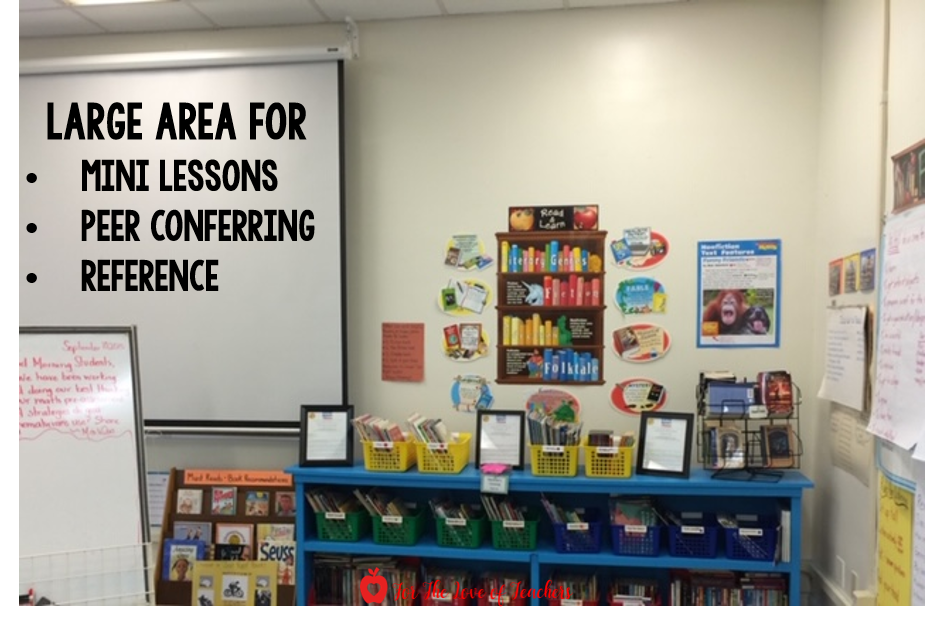
Status of the Class:
Allows teachers to know the status of each student’s progress at a given point of time. Ex. Students place their name cards onto the chart (pocket chart, dry erase board, etc.) to indicate where they are in the writing process.
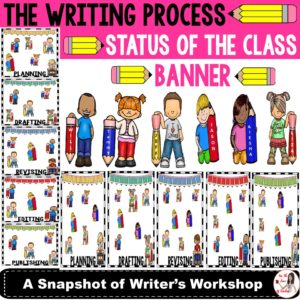
Writing Time
Student’s Role:
• Writes for 20-30 minutes
• Confer with peers (students meet with a “peer writing coach”)
• Confer with teacher
Teacher’s Role:
• Write with students
• Confer with students
• Small group mini lesson
Conferring- Meet with individual students to teach the writer, not the writing
-
Have procedures and expectations in place
-
Focus on one thing
-
Keep it brief, check back with the student
Conference Questions:
-
What are you working on?
-
What can I help you with?
-
What would you like to focus on?
-
Can you read me some of what you’ve got?
-
What are you going to do next?
*Peers could confer with each other too. Train students to become peer writing coaches.
Sharing:
-
Gives writers a chance to address a real audience and get valuable feedback
-
Students give kind, helpful, and specific feedback or ask thoughtful questions
-
Display student work
Need help introducing Writer’s Workshop? Check out this resource to help you get started.
Introducing Writer’s Workshop
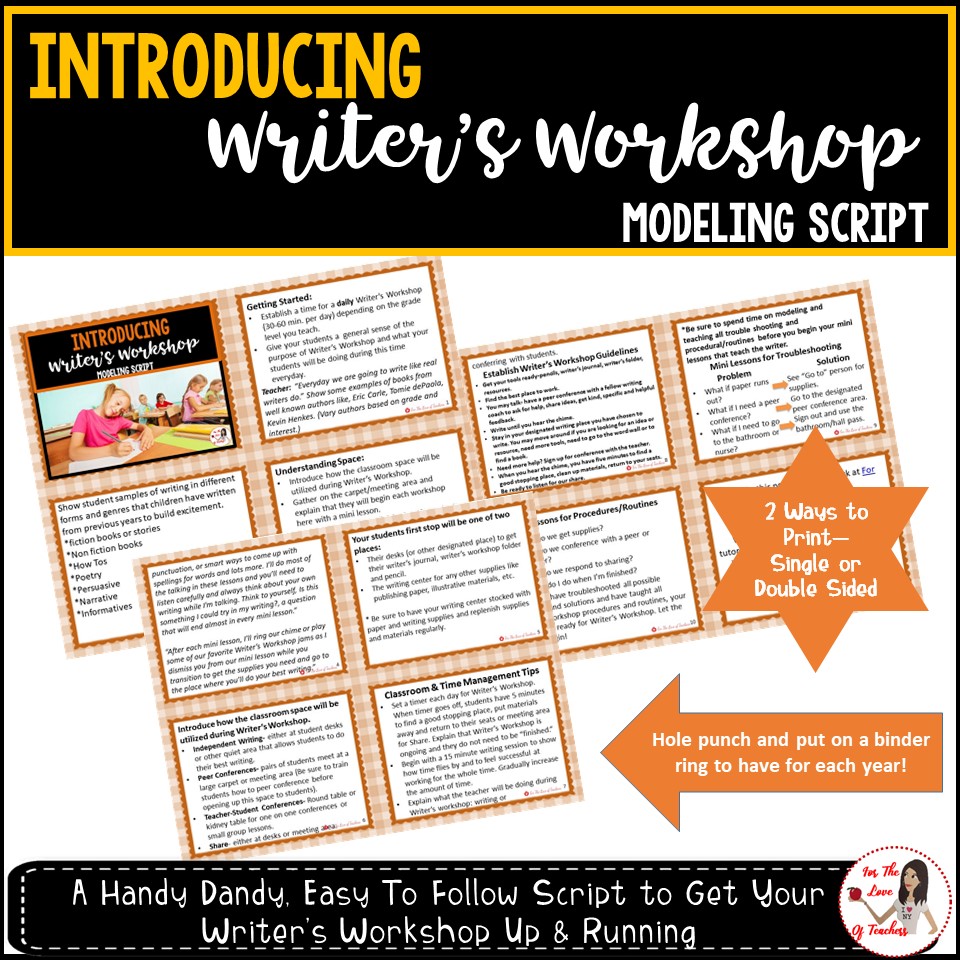
Introducing Writer’s Workshop takes time and organization. Setting the stage, tone and physical space of the classroom is important when launching. Modeling and teaching routines and procedures to your students set the expectations for your Writer’s Workshop from the start. Use this script to introduce Writer’s Workshop in your classroom. Get it here!
Here are some of my favorite FREE resources to launch Writer’s Workshop. Give them a try!
PDF] Writing Workshop-First 20 days
[PDF] The First 20 Days of Writer’s Workshop
About the Authors: Writing Workshop with Our Youngest Writers
Writing Like Writers: Guiding Elementary Children Through a Writer’s Workshop This book is awesome for teaching mini-lessons and for creating my PD workshops. It has fantastic text examples too.
This book is awesome for teaching mini-lessons and for creating my PD workshops. It has fantastic text examples too.
The Writing Thief: Using Mentor Texts to Teach the Craft of Writing . This book has great examples of mentor texts to teach narrative, informational, and persuasive writing.
. This book has great examples of mentor texts to teach narrative, informational, and persuasive writing.
Be a Better Writer: For School, For Fun, For Anyone Ages 10-15 (The Be a Better Writer Series) This book is an excellent resource for all writers including students, parents, bloggers, or anyone that just wants to be a better writer. This book offers effective techniques and strategies that are immediately useful.
This book is an excellent resource for all writers including students, parents, bloggers, or anyone that just wants to be a better writer. This book offers effective techniques and strategies that are immediately useful.
For The Love of Teachers’ Resources
Personal Narrative Writing Unit
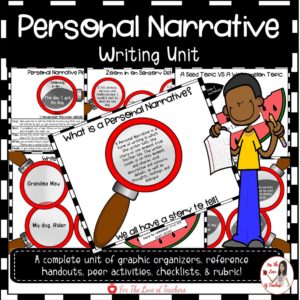
It includes all you need to make teaching personal narratives a breeze. In this unit, I incorporated visual graphic organizers, teacher examples to use for whole group lessons, discussions, and peer activities, along with checklists, publishing paper, and a rubric. Check it out here.
See my Personal Narrative Guided Writing Unit: Google Slides here. Perfect for distance learning and classroom use.
Informative Writing Unit
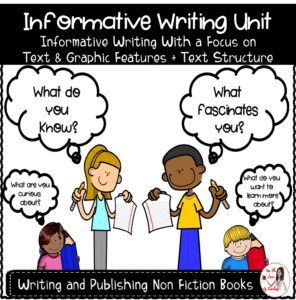
Informative writing doesn’t have to be boring with just a regurgitation of facts. This informative writing unit is all about the writer. When writers choose topics they are fascinated with and know a lot about, their voice and passion come through, adding interest to the writing while teaching the readers.
This writing unit guides students through the writing process by giving example slides for each part and then a slide for students to try what was modeled. Kind of like an “I do” example and then a “You do” your turn. In the notes section of each slide, there are directions as needed. On the “Your Turn” slides, students just need to add text in the text boxes that are already there. Confer with your students by sharing it with one another to view, edit, and comment. Students can confer with each other and engage in peer activities when they share their work with peers in just the same way.
**RECENTLY REVISED** This unit is entirely in google slides. Just make a copy and share it with your students. Check it out here.
Opinion Writing: Guided Unit
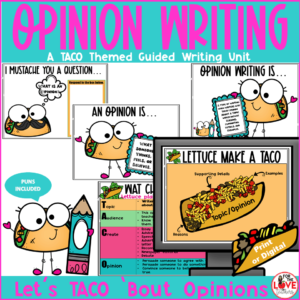
One of my favorite writing units to teach is opinion/persuasive writing. Teaching students how to respectively share and discuss opinions are so important. We love to have friendly debates and discuss hot topics. This writing unit is taco-themed, interactive, and has lots of fun taco puns. I incorporated visual graphic organizers, posters, student handouts, teacher examples to use for mini-lessons, activities, and peer activities. There are also lots of checklists and a rubric. You can use this resource in Google Slides (digital), print it for in-classroom use, or both! Includes a teacher guide with a suggested timeline, how to use these slides, and ideas for mini-lessons. See all that’s included here.
Mystery Writing
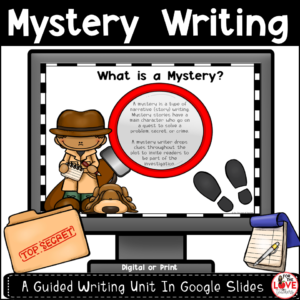
Writing a mystery is so fun! This writing unit guides students through the process of writing a mystery by giving example slides for each mini-lesson and then a slide for students to try what was modeled. Kind of like an “I do” example and then a “You do” your turn. This unit is entirely in google slides. Make a master copy for yourself and share a copy or parts of a copy, with your students. On the “Your Turn” slides, students just need to add text in the text boxes that are already there. The text boxes are not visible just in case you want to print this resource. You can confer with your students by sharing it with one another to view, edit and comment. Students can confer with each other and engage in peer activities when they share their work with peers in just the same way. This resource can also be presented and done as whole group mini-lessons which you can find in the suggested teacher guide. You can also print this resource. There are slides that are good for in-person groups, handouts, and peer conferring activities. Check out all that’s included here.
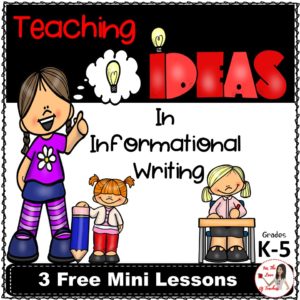
Check out these FREE mini lessons for Teaching the Six Traits in Informational Writing- Ideas. These lessons are part of a bundle that includes 18 mini-lessons that teach the six traits of writing (ideas, organization, voice, sentence fluency, word choice, and conventions) and is intended for grades K-5 within informational writing. These lesson plans were developed as a resource to support teachers in teaching the six traits using the mentor texts and lesson ideas that were expanded upon from the book The Writing Thief, by Ruth Culham, which is a trait-based strategy to assess and teach writing. All ideas and verbiage from The Writing Thief are clearly cited directly back to the book.
Teaching the Six Traits Mini-Lessons: Informational
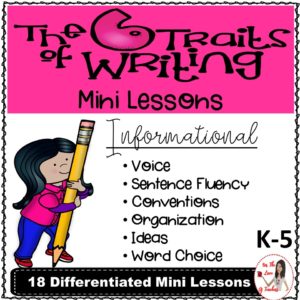
Each trait comes with 3 mini lessons for grades K-1, 2-3, and 4-5. The lessons are designed for differentiation so you could use the lessons below, at, or above the grade level you teach. You could teach the ‘at grade level’ lesson to your whole group, enrich or accelerate using the ‘above grade level’ lessons in small groups and use the ‘below grade level’ lessons for your struggling readers and writers in small groups as well.
Includes a list of mentor texts and 18 mini-lessons to teach the 6 traits in informational writing. Get it here.
Teaching the Six Traits in Narrative Writing
Test drive these FREE mini lessons for teaching the trait of IDEAS in Narrative Writing -Ideas. These lessons are part of a bundle that includes 18 mini-lessons that teach the six traits of writing (ideas, organization, voice, sentence fluency, word choice, and conventions) and is intended for grades K-5 within narrative writing.
Includes a list of mentor texts and 18 mini-lessons in narrative writing. Get it here.
Teaching the Six Traits in Persuasive Writing
Want it all?
Get the MEGA bundle of 54 mini lessons that teach the six traits in informational, narrative, and persuasive/argument/opinion writing here.
Here are grade-level mini lessons for teaching the six traits of writing in narrative, informative, and persuasive: K-1, 2-3, 4-5
Other Six Traits of Writing Resources
As we teach and encourage students to become confident writers, we must give them the tools they need to be successful. This resource is especially helpful for teaching and reinforcing the 6 traits of writing.
The Six Traits of Writing Sticky Note and Poster Checklists
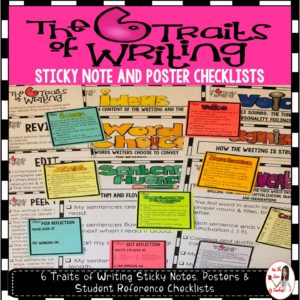
Six Traits of Writing Checklist Posters & Student Checklists
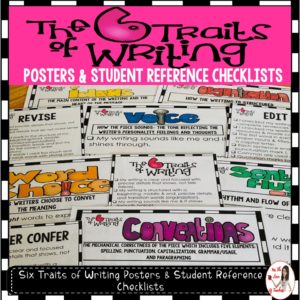
Six Traits of Writing Sticky Note Checklists
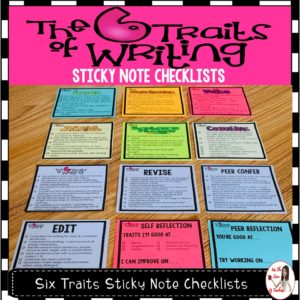
Revising Checklists: Six Traits of Writing
Revising Sticky Note Checklists
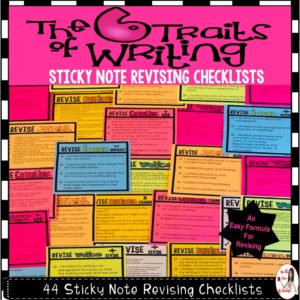
Revising Checklist Posters & Sticky Notes: Six Traits of Writing
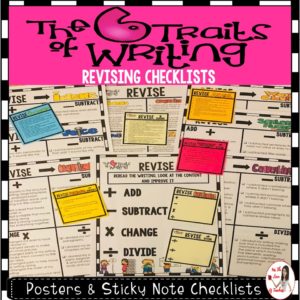
Writing Goals: Six Traits of Writing
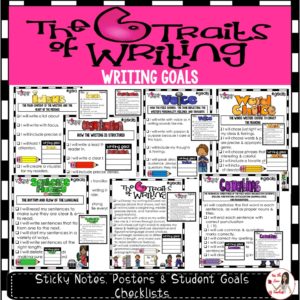
Six Traits of Writing Bundle
Do you need a more structured Writer’s Workshop? The Six Traits of Writing can do just that. The Six Traits guide and focus your students on what’s most important in their writing. As we teach and encourage students to become confident writers, we must give them the tools they need to be successful. This bundle includes posters, checklists, sticky notes, and goals for all things Six Traits of Writing throughout the writing process. Check out this BIG BUNDLE here.
The Writing Process
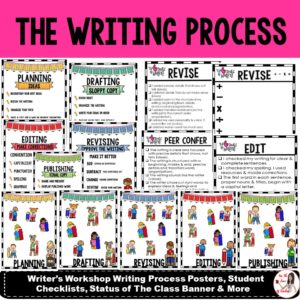
Check out The Writing Process Football Theme here.
The Writing Process Posters & Trifolds
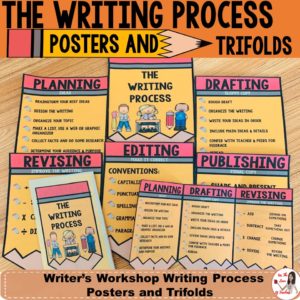
Just The Trifolds
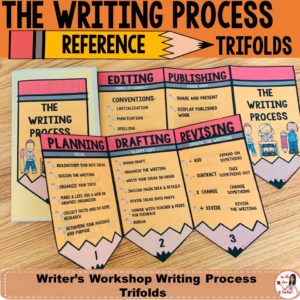
FATP
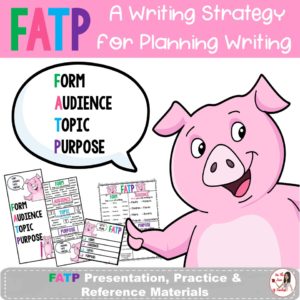
FATP is an acronym that stands for Format, Audience, Topic & Purpose. It is an excellent writing strategy for students to use to plan their writing. This resource helps to introduce, teach & practice using FATP to plan writing. Check out all the details here.
Writing Hooks Posters & Scavenger Hunts
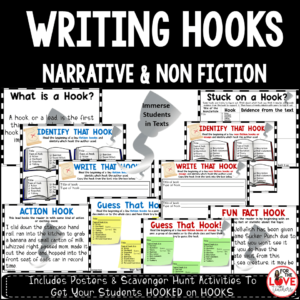
Are your students having trouble with writing strong leads? This resource will help you teach students how to write hooks or leads by immersing them in both fiction/narrative and non-fiction texts from books that they love to read and books that are in the classroom or school library: read alouds, picture books, chapter books news articles, any books either in print or digital! Texts serve as models for good writing that help students mimic in their own writing. Students participate in a variety of scavenger hunt activities that get students thinking, talking, and writing strong hooks and leads! Scavenger Hunts are a fun and engaging distance learning activity! Check out all that is included in this resource here.
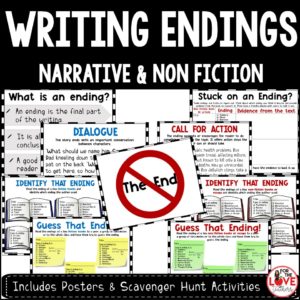
Do your students struggle with writing good endings for either narrative or non-fiction writing? This resource will help you teach students how to write endings by immersing them in both fiction/narrative and non-fiction texts from books they love to read and books that are in the classroom or school library: read alouds, picture books, chapter books, informational books, news articles, essays, or any other books either in print or digital! Texts serve as models for good writing that help students mimic in their own writing. Students participate in a variety of scavenger hunt activities that get students thinking, talking, and writing good endings! Scavenger Hunts are a fun and engaging distance learning activity! Check out this resource here.
Want Both? Get the BUNDLE! Writing Hooks and Writing Endings: Posters & Scavenger Hunt Activity
Writer’s Heart
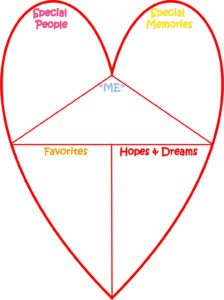
Students are less reluctant to write when they know the topic well and the topic matters to them. The Writer’s Heart is perfect for generating “seed” ideas, small, one time, ideas/topics that matter most to students. These seed ideas then turn into memoirs, personal narratives, an autobiography, and more. Get the FREE Writer’s Heart here.
Writer’s Workshop Toolkit
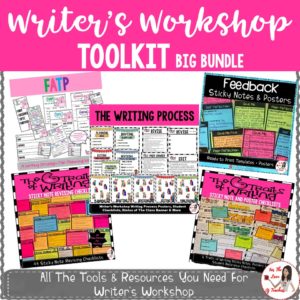
In order for a Writer’s Workshop to be successful, you & your students need the right tools and resources. This toolkit has various must-have resources that every Writer’s Workshop needs.
Includes 5 BIG Resources:
*The Writing Process
*FATP (Planning)
*Student Feedback Sticky Notes & Posters (Conferring)
*Revising Sticky Notes (Revising)
*Six Traits of Writing Sticky Notes, Posters & Checklists (For The Writer)
AND…Lots of Extras! Check it out here.
Want to learn more about organizing and managing Writer’s Workshop?
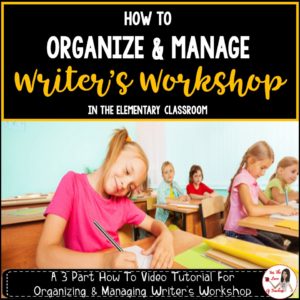
Check out my video tutorial here.
Want a FREE guide for organizing and managing Writer’s Workshop? Get it here to get started!
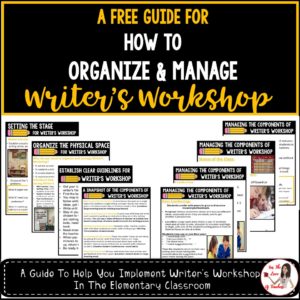
Writer’s Workshop Boot Camp Mini-Course

Many of my resources are offered in the Writer’s Workshop Boot Camp Mini-Course. You’ll get the tools and resources you need to organize and manage Writer’s Workshop and transform your students into writers.
Here’s a Sneak Peek:
Day 1: Organizing & Managing Writer’s Workshop Video Tutorial- You’ll learn how to set up your Writer’s Workshop regarding the tone, physical space, and all the components.
Day 2: Transforming Your Students Into Writers- You’ll learn 4 ways to get your students to LOVE writing, the first step in transforming your students into writers.
Day 3: Launching Writer’s Workshop- You’ll get easy-to-implement resources to launch your Writer’s Workshop, like my writer’s workshop script and my Writer’s Heart activity, plus a guide for the first 20 days.
Day 4: Teaching The Writer- You’ll get my ultimate BUNDLE of lesson plans that include 54 lessons that teach the six traits of writing (ideas, organization, voice, sentence fluency, word choice, and conventions) and is intended for grades K-5 within all 3 genres (18 lesson plans each) of informational, narrative and persuasive/narrative/opinion writing.
Day 5: Teaching By Genre- You’ll get some AMAZING structured resources to teach by genre (narrative, informational and persuasive/argument), including my Personal Narratives and Informative Writing Unit, which both include lots of visual graphic organizers, teacher examples to use for whole group lessons, discussions and peer activities, along with checklists, publishing paper, and a rubric.
Day 6: Writer’s Workshop Toolkit- You’ll get essential tools, like rubrics, checklists, and more, that every Writer’s Workshop needs. I threw in my bestselling Feedback Sticky Notes too…woot!
Day 7: The Secret- You’ll learn the secret to getting your students to write.
Want in? Check it out here.
Other Writing Resources
Autobiography (Best Seller)

This autobiography could be used at any time of the year. I’ve used it when teaching informative writing, as a getting to know you activity at the beginning of the year, and also as an end of year keepsake. Now in GOOGLE SLIDES!
Peer Biography
